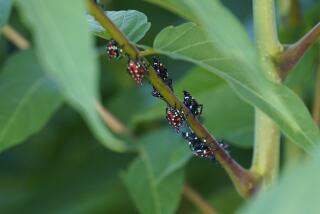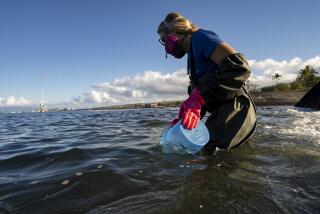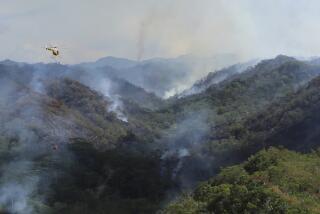Tiny wasp brings a big problem for crops in Hawaii
HONOLULU â The wiliwili trees began dying in the summer of 2005. Since then, wiliwili groves on all the Hawaiian islands have been devastated, leaving barren plains in their stead.
For each tree, it was the same process: First, gnarled lumps would appear on the leaves. Then the leaves and branches would turn brown. Within months, the tree would be dead.
Scientists determined that the culprit was a tiny predatory wasp from Africa, only recently discovered by science. Botanists named it the erythrina gall wasp: erythrina for the type of tree it attacks, and gall for the tumors it creates in leaves. An adult gall wasp is one-third the size of a typical mosquito.
âItâs tiny, like dust, but the damage it causes is unbelievable,â said Mohsen Ramadan, a state entomologist who characterized the epidemic as one of the worst problems ever caused in Hawaii by an invasive species. Trees killed by the gall wasp number in the thousands, from inner-city neighborhoods in Honolulu to rural farms on Molokai and desert-like plateaus on Kauai and the Big Island -- all in a short period.
Now, state officials hope to introduce a predator from Tanzania, the eurytoma wasp, as the last best hope to save the wiliwili trees. Officials must first prove the new insect will not harm any other species. The approval process, according to Ramadanâs boss, Neil Reimer of the state Department of Agriculture, could take three months or three years. The state is also seeking comments from the public.
Introducing new species as a biological-control agent has always been a tricky proposition in Hawaii, where nonnative plants and animals have wreaked havoc on native species. The best known biological-control failure involved the mongoose.
The sugar industry brought them to Hawaii to control the rat population (believed to have been brought by ancient Polynesians). But the mongooses, active chiefly in the daytime, did not prey on nocturnal rats. Instead, they went after the islandsâ native birds. Mongooses continue to menace bird populations on the islands.
âWeâre going to win some, weâre going to lose some,â said Art Medeiros, a biologist on Maui. Medeiros is collecting and preserving the seeds of native wiliwilis in case the trees are wiped out by the gall wasps. He said if native wiliwilis died off, vast stretches of land on Maui would become deserts.
Native wiliwilis have orange or red bark with green leaves divided into three parts and colorful red flowers. They can grow to more than 30 feet in height and three feet in diameter at the trunk.
The type of wiliwili most affected by the gall wasp is sometimes referred to as a coral tree. It is tall and thin, with branches and green leaves that begin from the ground up.
Coral trees have been used for years as windbreaks. Planted in a line, they form living green walls. According to Christy Martin of the state Coordinating Group on Alien Pest Species, on Molokai, farmers who shielded crops and fields with coral trees have struggled against wind damage since the gall wasp nearly wiped out the islandâs coral-tree population.
Martin said that a large wiliwili tree that âprovided shade for half a blockâ outside her office at the University of Hawaii-Manoa campus succumbed to the gall wasp. It had to be cut down before it simply fell over.
Honolulu city workers have cut down more than a thousand dead or dying wiliwilis in parks and medians.
Martin explains that the wasps inject their eggs into leaves, and its larvae form galls where the wasp matures. The galls deform the leaves and interfere with the plantâs ability to take in water and light, eventually causing the treeâs death.
A female gall wasp, whose life only lasts two to three weeks, can produce as many as 150 wasps.
Beginning last year, Ramadan took two extended trips to Africa to research the wasp and, most important, to find a remedy. During his travels in Africa, Ramadan noted that although gall wasps could be found, they did not seem to devastate tree populations as in Hawaii.
The reason, he said, was the presence of natural predators that kept the gall wasp population in check. One was the eurytoma wasp, which looks similar but is black. The gall wasp is mostly orange.
The eurytoma wasp kills its cousin by inserting its eggs into galls containing gall-wasp larvae. The eurytoma wasp, which matures faster, hatches and eats the gall-wasp larvae.
Ramadan said there was no way to know for sure how the gall wasps made their way to Hawaii, although they probably hitchhiked on luggage or cargo transported by plane. Some of the highest concentrations of infested wiliwili trees are found at or around the stateâs airports.
âTheyâre so small they could be transported easily without being seen,â he said of the wasps.
Ramadan said he believes the wasp species traveled from Africa across the Indian Ocean to China and Taiwan and then across the Pacific to Hawaii.
The wasp was first described as a new species in a 2004 scientific journal that studied samples from Singapore and East Africa.
--
More to Read
Sign up for Essential California
The most important California stories and recommendations in your inbox every morning.
You may occasionally receive promotional content from the Los Angeles Times.










